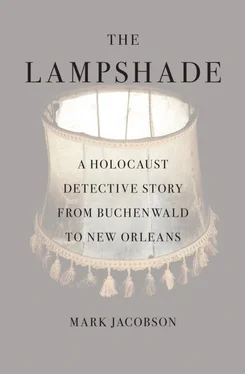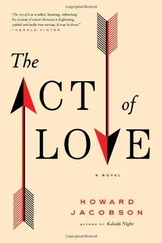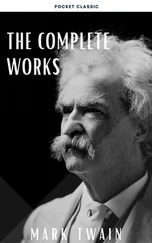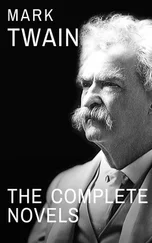Dresden firebombing in, 296—98
start of, 239
Wright, Jonas, 100
Xipe Totec, 101, 102
Yad Vashem, 113, 116, 154, 166, 255—57, 264—67, 274
Farid’s visit to, 272—73
German influence at, 276
yellow fever, 30
Yosef, Ovadia, 278
YouTube, 142
ZAKA (Disaster Victim Identification), 290—91
Ziereis, Franz, 13
Zionists, 115, 144, 147, 148, 250, 264, 288, 323 n
zoo, Buchenwald, 11
Zulu Social Aid and Pleasure Club, 36
Zyklon B, 135
American Gangster
Teenage Hipster in the Modern World
12,000 Miles in the Nick of Time
Everyone and No One
Gojiro

Simon & Schuster
1230 Avenue of the Americas
New York, NY 10020
www.SimonandSchuster.com
Copyright © 2010 by Mark Jacobson
All rights reserved, including the right to reproduce this book or portions thereof in any form whatsoever. For information address Simon & Schuster Subsidiary Rights Department, 1230 Avenue of the Americas, New York, NY 10020.
First Simon & Schuster hardcover edition September 2010
SIMON & SCHUSTER and colophon are registered trademarks of Simon & Schuster, Inc.
For information about special discounts for bulk purchases, please contact Simon & Schuster Special Sales at 1-866-506-1949 or business@simonandschuster.com.
The Simon & Schuster Speakers Bureau can bring authors to your live event. For more information or to book an event, contact the Simon & Schuster Speakers Bureau at 1-866-248-3049 or visit our website at www.simonspeakers.com.
Designed by Akasha Archer
Manufactured in the United States of America
10 9 8 7 6 5 4 3 2 1
Library of Congress Cataloging-in-Publication Data is available.
ISBN 978-1-4165-6627-4
ISBN 978-1-4165-6630-4 (ebook)
PHOTO CREDITS (by page number):
Courtesy of Mark Jacobson: 12, 63, 82, 95, 212, 287, 299, 313, 327
Courtesy of Skip Henderson: 33, 192, 310
Courtesy of Ken Kipperman: 136
Photograph used with permission of the Musée de la Résistance et de la Déportation: 10
Photograph by Ruben R. Ramirez, used with the permission of the El Paso Times: 162, 165
Courtesy of Sovfoto: 106
The story of selling one’s soul to the devil for temporal reward has long been among the most reliable narratives in world culture, but for Goethe and his German readers it was essentially a local story, with its roots quite close to the Ettersberg forest. An early mention of “Faust” turns up in a letter sent from one Trithemius, abbot of Würzberg and noted occultist, to Johann Virdun, an astrologer in Heidelberg. Dated August 20, 1507, the letter warns against a “Magister Georgius Sabellicus, Faustus junior,” who has been passing himself off as the “prince of necromancers.” Six years later, in 1513, there is a mention of a “Georgius Faustus,” who is now described as “cheiromancer,” or palm reader, supposedly operating in Erfurt, fifteen miles from Weimar. This was followed, in 1587, by the first of the “Faust books,” under the all-inclusive title History of Dr. Johann Faust, the notorious Magician and Necromancer, how he sold himself for a stipulated Time to the Devil, What strange Things he saw, performed and practised during this Time, until at last he received his well-merited Reward. A popular hit, it was widely read in Weimar, as was the later Christopher Marlowe adaption of the legend. Goethe’s version signified something of a homecoming for the Faust story.
Buchenwald doctor Erich Wagner, whose thesis on tattooing was supposedly read by Ilse Koch (the thesis itself appears on the Buchenwald Table, at the base of the lampshade), was brought to the United States as a prisoner of war. Escaping custody, Wagner returned to Europe, where he practiced medicine under an assumed name until he was recaptured. He committed suicide in prison in March 1959. Wagner’s work in the identification of “criminal types” seems to lean heavily on the ideas of Cesare Lombroso, the nineteenth-century Italian psychiatrist and surgeon who is generally considered to be the father of modern criminology. Born into a well-to-do Sephardic family in Verona, Lombroso believed that “born criminals” could be recognized through eugenic-based characteristics of “biological determinism” such as handle-shaped ears, hawklike noses, and insensitivity to pain. It was Lombroso’s belief that individuals displaying these signs of “atavistic stigmata” were more likely to have tattoos. Studies of the connection between tattooing and criminal activity of groups like the yakuza, Russian crime societies, and Latin American gangs are now standard police work. While gang tats can be quite elaborate, the old-style jailhouse tattoo remains an entire genre of self-branding. Most prison tats are quite primitive, owing to the meager resources at hand, with colors restricted to blue or black. Most are still done “freehand,” by a needle dipped in ink, but homemade tat machines, usually powered by a small motor and a 9-volt battery, are also common. For a wide array of what’s available to the long-term jailbird, check http://www.eviltattoo.com/pr.
Clarksdale, known as “The Golden Buckle of the Cotton Belt,” was the key commercial center of the Mississippi Delta, the most fertile (along with the Nile Valley) cotton growing area in the world. The concentration of cotton plantations and the later sharecropping system in the Delta did much to create the dynamic that produced African-American blues music. For an excellent overview of the social and economic conditions of the Delta at the time, see Nicholas Lemann’s The Promised Land: The Great Black Migration and How It Changed America (Vintage, 1992). Muddy Waters’s sharecropper shack once stood on the Stovall Plantation near Clarksdale until it was purchased and hauled away by the House of Blues on a flatbed truck. Many sign-waving local music fans chased after the truck screaming, “Don’t take Muddy’s house away.”
The monument Skip Henderson helped erect at Mount Zion Church was never intended to mark Johnson’s actual burial spot. The other “gravesites” are at the Little Zion Missionary Baptist Church in Greenwood, Mississippi, and near the Payne Chapel Memorial Baptist Church in Quito, Mississippi. Robinsonville, a small town near the Tennessee border where Johnson lived for some years, is now home to several legalized gambling casinos with lounges mostly featuring second-string country artists, an irony the soul-selling Johnson might have appreciated.
NASA’s version of the Ed White spacewalk incident includes no mention of any feelings of intoxication on the astronaut’s part. It does, however, quote the astronaut as saying his extravehicular activity (EVA), which lasted twenty-three minutes, was “the most comfortable part of the mission,” and that having it end was the “saddest moment of my life.”
The most interesting work on New Orleans’s ever-changing geography has been done by Richard Campanella. A New Orleans resident, his books include Bienville’s Dilemma , Time and Place in New Orleans, and Geographies of New Orleans: Urban Fabrics Before the Storm .
But the bon temps does not rouler for long in the Crescent City. Only two months after Skip Henderson received the sacrament of Ash Wednesday, he was back on the Bus, in emergency mode. On Tuesday, April 20, 2010, the 121st anniversary of Adolf Hitler’s birth, the Deepwater Horizon rig blew up in the Gulf of Mexico, fifty miles off the Louisiana coast. Eleven people were killed and the resulting spill, the biggest in American history, threatens to wipe out the fishing industry on the Gulf Coast and befoul millions of acres of wetlands. Even as the Treme TV show reprised the nightmare life following Katrina on HBO, the fabled, wounded city suffered another blow. Again, the old, bad feeling of neglect from both the private and public sectors was ambient. One thing that was sure, the price of a po’ boy made with real, unfrozen shrimp was going to go through the roof. From Skip Henderson’s point of view, it meant more weeks of getting up at four thirty in the morning to drive the Bus down to Port Sulphur in Plaquemines Parish. The Plaquemines unemployment office was wrecked in the storm and never rebuilt, so Skip was enlisted to help out. “I am the Plaquemines Parish unemployment office,” he wailed. What was worse was the return of the national media to the Louisiana coast. Skip called me the other day from Port Sulphur to complain about the way things were going, when a loud noise came across the line. Screaming over the din, Skip said, “They’re landing a goddamn helicopter, right next to the Bus. There’s no end to this.”
Читать дальше













